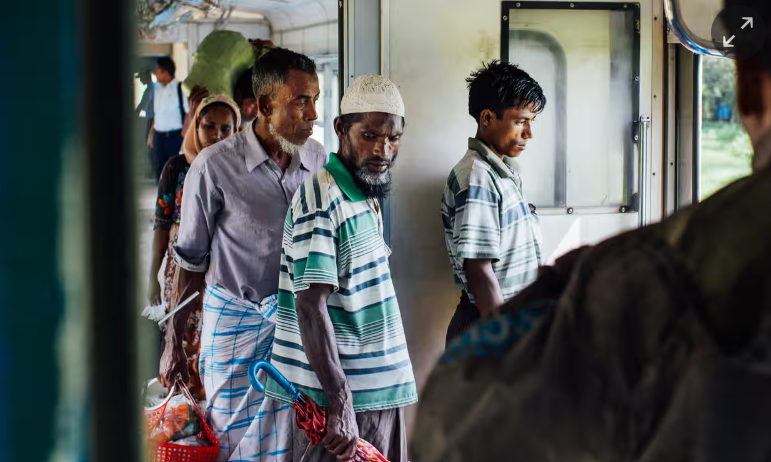Rohingya being forcibly conscripted in battle between Myanmar and rebels
By Betsy Reed, Editor
Guardian US
14 May 2024
Myanmar military has conscripted 1,000 Rohingya men and boys since February, with fears some are being used as human shields, according to NGOs

For more than four hours Abdullah* waited in the darkness as soldiers marched 30 of his neighbours from their homes in the Myanmar border state of Rakhine and forced them by gunpoint to join him on the truck that would take them all to a military base.
By the morning they were standing in front of a military commander ordering them to fight with the army against a local rebel group – some of the 1,000 Rohingya people the Myanmar military has conscripted since February, according to Human Rights Watch.
“The general told us that the Arakan Army [the rebel group] had invaded the area and it was our responsibility to protect ourselves because the general public was dying when the army attacked our areas,” said Abdullah, who had spent the past two weeks trying to hide from the military after hearing rumours about conscription.
Myanmar’s military has been losing ground in Rakhine to the Arakan Army, which is composed of the local Buddhist Rakhine ethnicity. The UN has said the military’s forced conscription, which aims to recruit 5,000 people a month, is an attempt to reverse the losses of troops to casualties and defections.
The conscription law was only supposed to apply to citizens and, in theory, not Rohingya, a mostly Muslim ethnic minority who were stripped of citizenship by a 1982 law that has underpinned decades of persecution.
Rohingya have reported both sides pressuring them to fight, depending on who controls the area they live in, but many fear they are simply being thrown into the battlefield as human shields.
“I saw lots of dead bodies at the base and if the soldiers who had training for six months were being killed in fighting, how could we fight the rebels after just 10 days of training? It was impossible. I was sure we would die fighting,” said Abdullah.
Abdullah tried to persuade others to escape but they feared their families would be punished in retaliation. Ultimately, he was able to flee by himself, heading for Bangladesh because of the conditions in Rakhine.
Another Rohingya man, living in the Rakhine state capital, Sittwe, said: “I don’t feel safe. If I pass through government checkpoints they will force me to serve in the military. I just stay in my home to avoid arrest.”
Recently, activists have reported that armed gangs are abducting young men in refugee camps in Bangladesh, where close to a million Rohingya live, and taking them to Myanmar, where they could be forced to fight.
One Rohingya man living in Bangladesh told the Guardian that his 19-year-old nephew and two other boys were taken to Myanmar in early May by a group of armed men and have not been heard from since.
“People say the youth who are abducted are sold to the Myanmar government,” the Rohingya man said. “Their parents cannot find them. They are trying their best, but not one is found.”
The UN’s human rights chief, Volker Türk, warned in April that the Rohingya are “trapped between two armed factions who have a track record of killing them”.
The UN also warned that the pitting of the Rohingya and Rakhine against each other could inflame intercommunal tensions and lead to retaliatory violence.
Over the past week, activists have reported arson attacks by the Arakan Army on Rohingya villages, while human rights monitors have also documented the forced relocation of Rohingya from at least eight villages under the army’s control to a single village.
James Rodehaver, the head of the Myanmar team at the UN’s Office of the High Commissioner for Human Rights, said the military and Arakan Army have often taken up positions on either side of Rohingya villages, trapping civilians in the middle.
“They suffer the consequences of the ensuing combat – airstrikes, forced displacement, village burnings, destruction of critical humanitarian infrastructure, especially medical facilities. Rohingya men have been arrested and disappeared, or even in some cases used as human shields by the military. Their mosques and schools have at times been occupied by fighters and used as locations from which to launch strikes, or damaged and destroyed during attacks.”
Nimrat Kaur, a project coordinator for Médecins Sans Frontières (MSF), who recently returned from Rakhine, said the violence may make it difficult for them to continue operating.
“We now have bare minimum teams there and our MSF office was burned down [in April],” he said. “We were maintaining a bare-minimum presence because we are a medical organisation. We have a principle and objective of bearing witness.”
Kaur said that both sides had been placing landmines near highly populated villages without telling the residents, which had resulted in injuries.
“The Rohingya population were already the most vulnerable, as they don’t have citizenship rights and don’t have access to move. Now they are stuck where they are,” said Kaur. “It was very difficult for them to hide from forced recruitment from authorities.”
*Name has been changed
